
Palace of the Grand Duke of Luxembourg, built in 1572. (782k)
From the Luxembourg City entry in Wikipedia:
Luxembourg, also known as Luxembourg City, is the capital city of the Grand Duchy of Luxembourg and the country's most populous commune. Standing at the confluence of the Alzette and Pétrusse rivers in southern Luxembourg, the city lies at the heart of Western Europe, situated 213 km (132 miles) by road from Brussels, 372 km (231 miles) from Paris, and 209 km (130 miles) from Cologne. The city contains Luxembourg Castle, established by the Franks in the Early Middle Ages, around which a settlement developed.
In the Roman era, a fortified tower guarded the crossing of two Roman roads that met at the site of Luxembourg city. Through an exchange treaty with the abbey of Saint Maximin in Trier in 963, Siegfried I of the Ardennes, a close relative of King Louis II of France and Emperor Otto the Great, acquired the feudal lands of Luxembourg. Siegfried built his castle, named Lucilinburhuc ("small castle"), on the Bock Fiels ("rock"), mentioned for the first time in the aforementioned exchange treaty.
In 987, Archbishop Egbert of Trier consecrated five altars in the Church of the Redemption (today St. Michael's Church). At a Roman road intersection near the church, a marketplace appeared around which the city developed.
The city, because of its location and natural geography, has through history been a place of strategic military significance. The first fortifications were built as early as the 10th century. By the end of the 12th century, as the city expanded westward around the new St. Nicholas Church (today the Cathedral of Notre Dame), new walls were built that included an area of 5 hectares (12 acres). In about 1340, under the reign of John the Blind, new fortifications were built that stood until 1867.
In 1443, the Burgundians under Philip the Good conquered Luxembourg. Luxembourg became part of the Burgundian, and later Spanish and Austrian empires and under those Habsburg administrations Luxembourg Castle was repeatedly strengthened so that by the 16th century, Luxembourg itself was one of the strongest fortifications in Europe. Subsequently, the Burgundians, the Spanish, the French, the Spanish again, the Austrians, the French again, and the Prussians conquered Luxembourg.
In the 17th century, the first casemates were built; initially, Spain built 23 km (14 miles) of tunnels, starting in 1644. These were then enlarged under French rule by Marshal Vauban, and augmented again under Austrian rule in the 1730s and 1740s.
During the French Revolutionary Wars, the city was occupied by France twice: once, briefly, in 1792–93, and, later, after a seven-month siege. Luxembourg held out for so long under the French siege that French politician and military engineer Lazare Carnot called Luxembourg "the best fortress in the world, except Gibraltar", giving rise to the city's nickname: the 'Gibraltar of the North'.
Nonetheless, the Austrian garrison eventually surrendered, and as a consequence, Luxembourg was annexed by the French Republic, becoming part of the département of Forêts, with Luxembourg City as its préfecture. Under the 1815 Treaty of Paris, which ended the Napoleonic Wars, Luxembourg City was placed under Prussian military control as a part of the German Confederation, although sovereignty passed to the House of Orange-Nassau, in personal union with the United Kingdom of the Netherlands.
After the Luxembourg Crisis, the 1867 Treaty of London required Luxembourg to dismantle the fortifications in Luxembourg City. Their demolition took sixteen years, cost 1.5 million gold francs, and required the destruction of over 24 km (15 miles) of underground defences and 4 hectares (10 acres) of casemates, batteries, barracks, etc. Furthermore, the Prussian garrison was to be withdrawn.
The Passerelle, also known as the viaduct or old bridge, overlooking the Pétrusse river valley. It opened in 1861. When, in 1890, Grand Duke William III died without any male heirs, the Grand Duchy passed out of Dutch hands, and into an independent line under Grand Duke Adolphe. Thus, Luxembourg, which had hitherto been independent in theory only, became a truly independent country, and Luxembourg City regained some of the importance that it had lost in 1867 by becoming the capital of a fully independent state.
Despite Luxembourg's best efforts to remain neutral in the First World War, it was occupied by Germany on 2 August 1914. On 30 August, Helmuth von Moltke moved his headquarters to Luxembourg City, closer to his armies in France in preparation for a swift victory. However, the victory never came, and Luxembourg would play host to the German high command for another four years. At the end of the occupation, Luxembourg City was the scene of an attempted communist revolution; on 9 November 1918, communists declared a socialist republic, but it lasted only a few hours.
In 1921, the city limits were greatly expanded. The communes of Eich, Hamm, Hollerich, and Rollingergrund were incorporated into Luxembourg City, making the city the largest commune in the country (a position that it would hold until 1978).
In 1940, Germany occupied Luxembourg again. The Nazis were not prepared to allow Luxembourgers self-government, and gradually integrated Luxembourg into the Third Reich by informally attaching the country administratively to a neighbouring German province. Under the occupation, the capital city's streets all received new, German names, which was announced on 4 October 1940. The Avenue de la Liberté for example, a major road leading to the railway station, was renamed "Adolf-Hitlerstraße". Luxembourg City was liberated on 10 September 1944. The city was under long-range bombardment by the German V-3 cannon in December 1944 and January 1945.
After the war, Luxembourg ended its neutrality, and became a founding member of several inter-governmental and supra-governmental institutions. In 1952, the city became the headquarters of the High Authority of the European Coal and Steel Community. In 1967, the High Authority was merged with the commissions of the other European institutions; although Luxembourg City was no longer the seat of the ECSC, it hosted some part-sessions of the European Parliament until 1981. Luxembourg remains the seat of the European Parliament's secretariat, as well as the Court of Justice of the European Union, the European Court of Auditors, and the European Investment Bank. Several departments of the European Commission are also based in Luxembourg.
The City of Luxembourg: its Old Quarters and Fortifications is a UNESCO World Heritage Site.
All pictures are © Dr. Günther Eichhorn, unless otherwise noted.













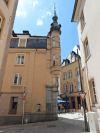


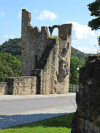

From the Notre-Dame_Cathedral, Luxembourg entry in Wikipedia:
Notre-Dame Cathedral (Luxembourgish: Kathedral Notre-Dame, French: Cathédrale Notre-Dame, German: Kathedrale unserer lieben Frau) is the Roman Catholic Cathedral of Luxembourg City, in southern Luxembourg. It was originally a Jesuit church, and its cornerstone was laid in 1613. It is the only cathedral in Luxembourg.
The church is a noteworthy example of late gothic architecture; however, it also has many Renaissance elements and adornments. At the end of the 18th century, the church received the miraculous image of the Maria Consolatrix Afflictorum, the patron saint of both the city and the nation.
Around 50 years later, the church was consecrated as the Church of Our Lady and in 1870, it was elevated by Pope Pius IX to the Cathedral of Notre-Dame.
At the cemetery of the cathedral is the National Monument to the Resistance and to the Deportation. The centerpiece of the monument is the famous bronze monument by the 20th century Luxembourgish sculptor Lucien Wercollier called The Political Prisoner.
The cathedral was expanded and enlarged from 1935 to 1938.
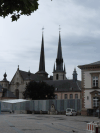


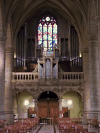
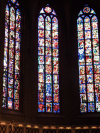
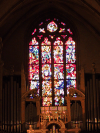
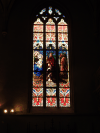
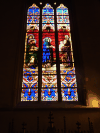
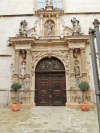


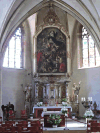

This page contains 31 pictures

Main page for Lëtzebuerg (Luxembourg)
Page last updated on Thu Jul 15 13:41:22 2021 (Mountain Standard Time)
Page last updated on Thu Apr 25 18:51:50 2024 (Mountain Standard Time)
Architecture in Luxembourg City on gei.geichhorn.com